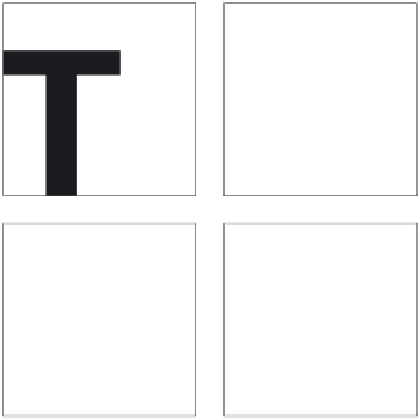Graphics Reference
In-Depth Information
STRUCTURE AND SPACE
4-3
Letterforms gain velocity as they move toward the
edges of space. Here, submitting to the force of gravity,
the letter
T
appears to topple.
Space is the common denominator for all typographic communication.
When typographic elements are introduced into space, they create
subliminal divisions, and these divisions create spatial structure. As
typographic elements shift syntactically in size, weight, and position,
new structures emerge (Fig.
4-2
).
Another way of thinking about type and its relationship to space
is to imagine a letterform as a point in space, the extension of a point
as a line in space (line of text), and the extension of a line as a plane in
space (text block). This analogy suggests that typographic elements are
kinetic in nature, that they are in perpetual motion.
Consider the single letterform. When centered, it appears
motionless. When placed off center, it appears to move, gaining
velocity as it approaches the outermost boundaries of the space. Rotate
the letter and it appears to tumble. Lines of type are put into motion
from the direction of their origin (usually left to right) at the moment
they are read. They suggest horizontal movement, unless of course
they are positioned vertically or at an angle in space. The kinetic
possibilities of typographic elements are potentially endless (Fig.
4-3
).
Firmly grounded by gravity, we are oriented to the earth in terms
of the horizontal and the vertical. We perceive the natural world
according to these opposites, and we create the built environment in
relationship to them. We are more comfortable with the horizontal—in
this realm we feel safe. The vertical dimension is more challenging—
we are afraid both of flying and of falling.
4-2
The shapes of
typographic elements
have directional
qualities that are echoed
as implied spatial
corridors. These divisions
establish proportional
relationships and give
the space movement and
kinetic energy.
The whole duty of
typography, as with calligraphy,
is to communicate to
The whole duty of typography, as with
The grid is a skeletal framework
used by designers to organize,
relate, and control content within
a spatial field. It is a system
characterized by the dualities of
freedom and constraint, simplicity
and complexity. It provides a
strategy for composing text and
other visual information in
two- and three-dimensional space,
including those of printed materials,
film, computer screen, built
environments, and typographic
installations. Grid systems aid
designers in making information
clear and optimally accessible
The grid is a skeletal framework
used by designers to organize,
relate, and control content within
a spatial field. It is a system
characterized by the dualities of freedom
and constraint, simplicity
and complexity. It provides a
strategy for composing text and
other visual information in
two- and three-dimensional space

























